2021 HYUNDAI SONATA HYBRID light
[x] Cancel search: lightPage 6 of 527
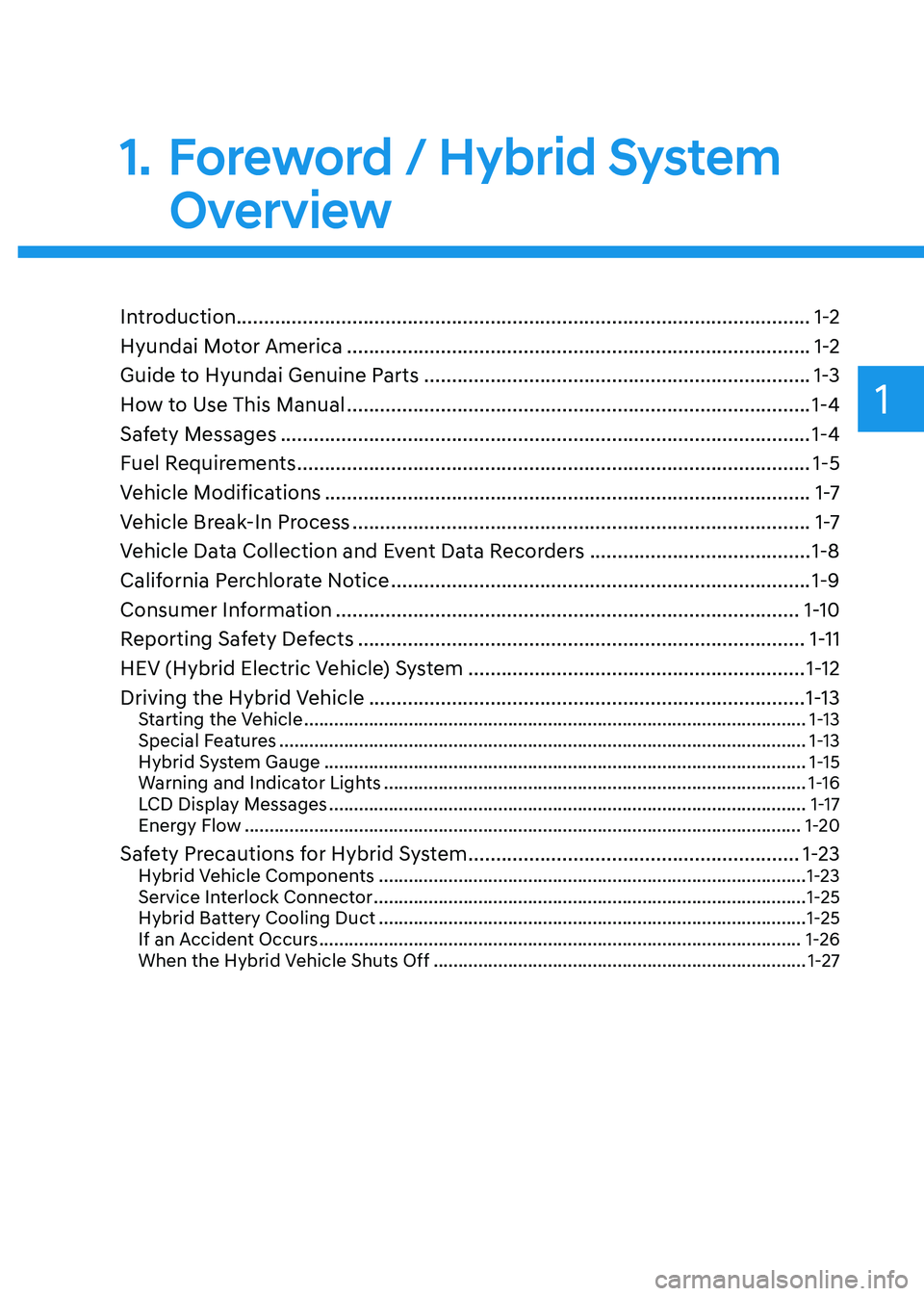
Introduction........................................................................\
................................1-2
Hyundai Motor America
........................................................................\
............1-2
Guide to Hyundai Genuine Parts
......................................................................1-3
How to Use This Manual
........................................................................\
............1-4
Safety Messages
........................................................................\
........................1-4
Fuel Requirements
........................................................................\
.....................1-5
Vehicle Modifications
........................................................................\
................1 -7
Vehicle Break-In Process
........................................................................\
...........1 -7
Vehicle Data Collection and Event Data Recorders
........................................1-8
California Perchlorate Notice
........................................................................\
....1-9
Consumer Information
........................................................................\
............1-10
Reporting Safety Defects
........................................................................\
.........1-11
HEV (Hybrid Electric Vehicle) System
.............................................................1-12
Driving the Hybrid Vehicle
........................................................................\
.......1-13Starting the Vehicle ........................................................................\
.............................1-13
Special Features ........................................................................\
..................................1-13
Hybrid System Gauge
........................................................................\
.........................1-15
Warning and Indicator Lights ........................................................................\
.............1-16
LCD Display Messages ........................................................................\
........................1-17
Energy Flow ........................................................................\
........................................1-20
Safety Precautions for Hybrid System ............................................................1-23Hybrid Vehicle Components ........................................................................\
..............1-23
Service Interlock Connector ........................................................................\
...............1-25
Hybrid Battery Cooling Duct ........................................................................\
..............1-25
If an Accident Occurs ........................................................................\
.........................1-26
When the Hybrid Vehicle Shuts Off ........................................................................\
...1-27
Foreword
1. Foreword / Hybrid System
Overview
1
Page 18 of 527

01
1-13
Starting the Vehicle
Vehicles with smart key system
1. Carry the smart key or leave it inside
the vehicle.
2. Make sure the parking brake is firmly
applied.
3. Make sure the shift button is in P
(Park). With the shift button in N
(Neutral), you cannot start the vehicle.
4. Depress the brake pedal.
5. Press the Engine Start/Stop button.
If the hybrid system starts, the “”
indicator will come on.
Whether the engine is cold or warm, it
should be started without depressing
the accelerator.
After following the start procedures,
“
” indicator on the instrument
cluster will turn on. For more details,
please check chapter 6.
ECONOMICAL and SAFE OPERATION of
Hybrid system
• Drive smoothly. Accelerate at a
moderate rate and maintain a steady
cruising speed. Do not make “jack-
rabbit” starts. Do not race between
stoplights.
• Avoid heavy traffic whenever possible.
Always maintain a safe distance
from other vehicles so you can
avoid unnecessary braking. This also
reduces brake wear.
• The regenerative brake generates
energy when the vehicle decelerates.
• When the hybrid battery power is
low, the hybrid system automatically
recharges the hybrid battery.
• When the engine is running with the
shift button in N (Neutral), the hybrid
system cannot generate electricity.
The hybrid battery cannot recharge
with the shift button in N (Neutral).
Information
In the hybrid system, the engine
automatically runs and stops. When
the hybrid system operates, the “
”
indicator is illuminated.
In the following situation, the engine may
operate automatically.
- When the engine is ready to run
-When the hybrid battery is being
charged
-Depending on the temperature
condition of the hybrid battery
Special Features
Hybrid vehicles sound different than
gasoline engine vehicles. When the
hybrid system operates, you may hear
a sound from the hybrid battery system
behind the rear seat. If you apply the
accelerator pedal rapidly, you may hear
an unconventional sound. When you
apply the brake pedal, you may hear
a sound from the regenerative brake
system. When the hybrid system is
turned off or on, you may hear a sound
in the engine compartment. If you
depress the brake pedal repeatedly
when the hybrid system is turned on,
you may hear a sound in the engine
compartment. None of these sounds
indicate a problem. These are normal
characteristics of hybrid vehicles.
If any of following occur, it’s a normal
condition if you hear a motor sound in
the engine compartment:
-After turning off the hybrid system,
the brake pedal is released.
-When the hybrid system is turned off,
the brake pedal is applied.
-When the driver door is opened.
DRIVING THE HYBRID VEHICLE
Page 21 of 527
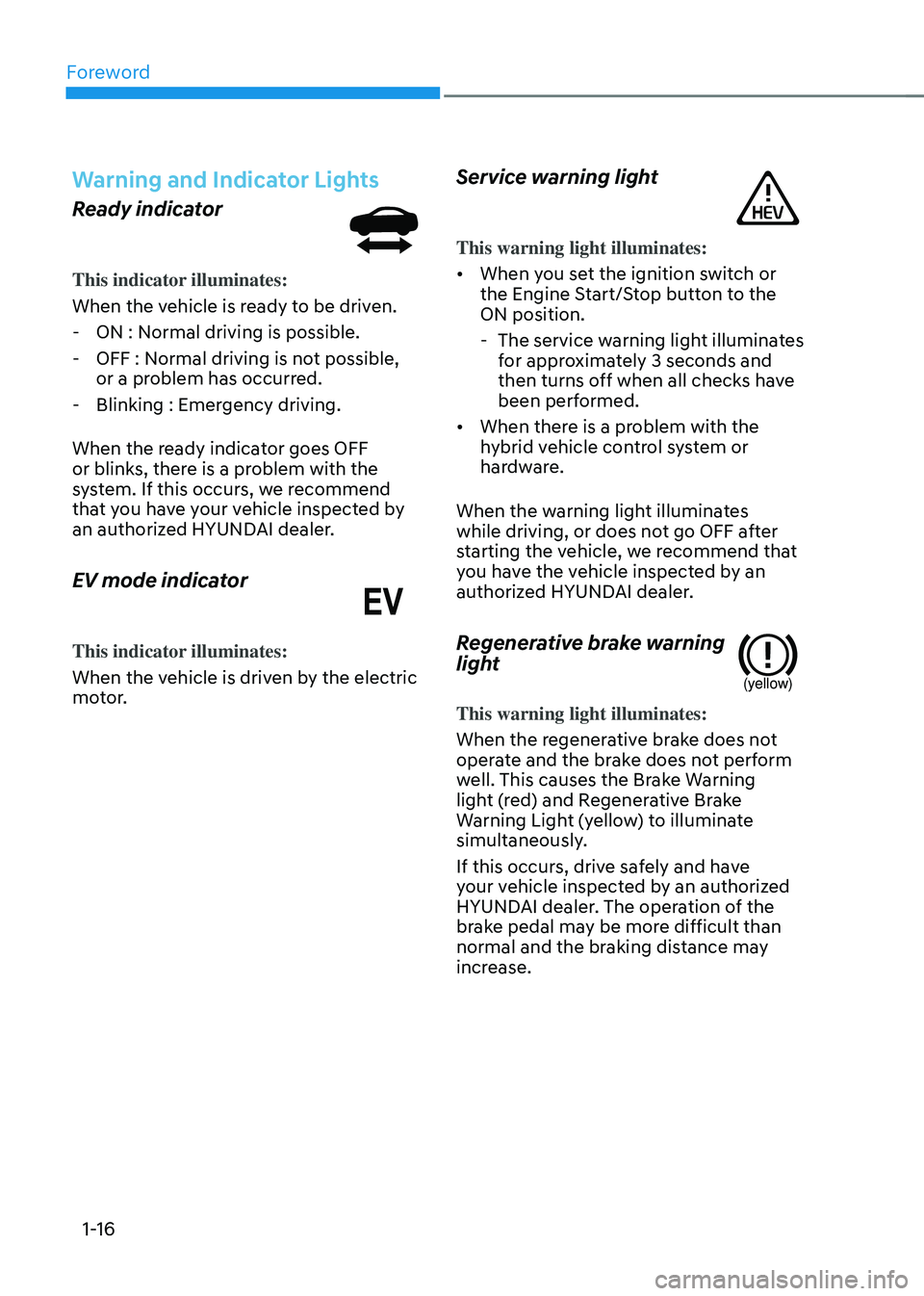
Foreword
1-16
Warning and Indicator Lights
Ready indicator
This indicator illuminates:
When the vehicle is ready to be driven.
-ON : Normal driving is possible.
-OFF : Normal driving is not possible,
or a problem has occurred.
-Blinking : Emergency driving.
When the ready indicator goes OFF
or blinks, there is a problem with the
system. If this occurs, we recommend
that you have your vehicle inspected by
an authorized HYUNDAI dealer.
EV mode indicator
This indicator illuminates:
When the vehicle is driven by the electric
motor.
Service warning light
This warning light illuminates:
• When you set the ignition switch or
the Engine Start/Stop button to the
ON position.
-The service warning light illuminates
for approximately 3 seconds and
then turns off when all checks have
been performed.
• When there is a problem with the
hybrid vehicle control system or
hardware.
When the warning light illuminates
while driving, or does not go OFF after
starting the vehicle, we recommend that
you have the vehicle inspected by an
authorized HYUNDAI dealer.
Regenerative brake warning
light
(yellow)
This warning light illuminates:
When the regenerative brake does not
operate and the brake does not perform
well. This causes the Brake Warning
light (red) and Regenerative Brake
Warning Light (yellow) to illuminate
simultaneously.
If this occurs, drive safely and have
your vehicle inspected by an authorized
HYUNDAI dealer. The operation of the
brake pedal may be more difficult than
normal and the braking distance may
increase.
Page 40 of 527
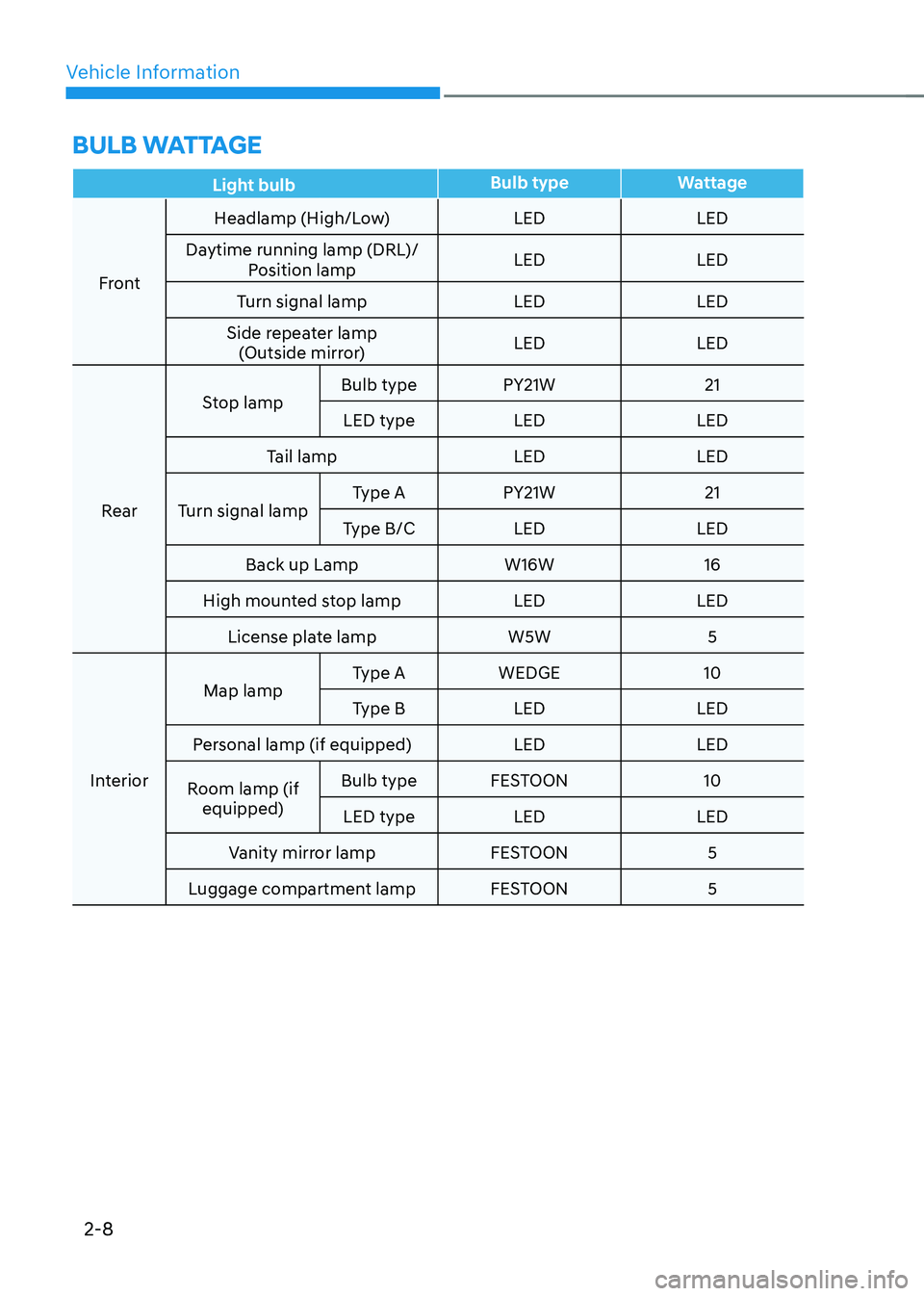
Vehicle Information
2-8
BULB WATTAGE
Light bulbBulb type
Wattage
Front Headlamp (High/Low)
LEDLED
Daytime running lamp (DRL)/ Position lamp LED
LED
Turn signal lamp LEDLED
Side repeater lamp (Outside mirror) LED
LED
Rear Stop lamp
Bulb type
PY21W 21
LED type LED LED
Tail lamp LEDLED
Turn signal lamp Type A
PY21W 21
Type B/C LED LED
Back up Lamp W16W16
High mounted stop lamp LEDLED
License plate lamp W5W5
Interior Map lamp
Type A
WEDGE 10
Type B LED LED
Personal lamp (if equipped) LEDLED
Room lamp (if equipped) Bulb type
FESTOON 10
LED type LED LED
Vanity mirror lamp FESTOON5
Luggage compartment lamp FESTOON5
Page 46 of 527
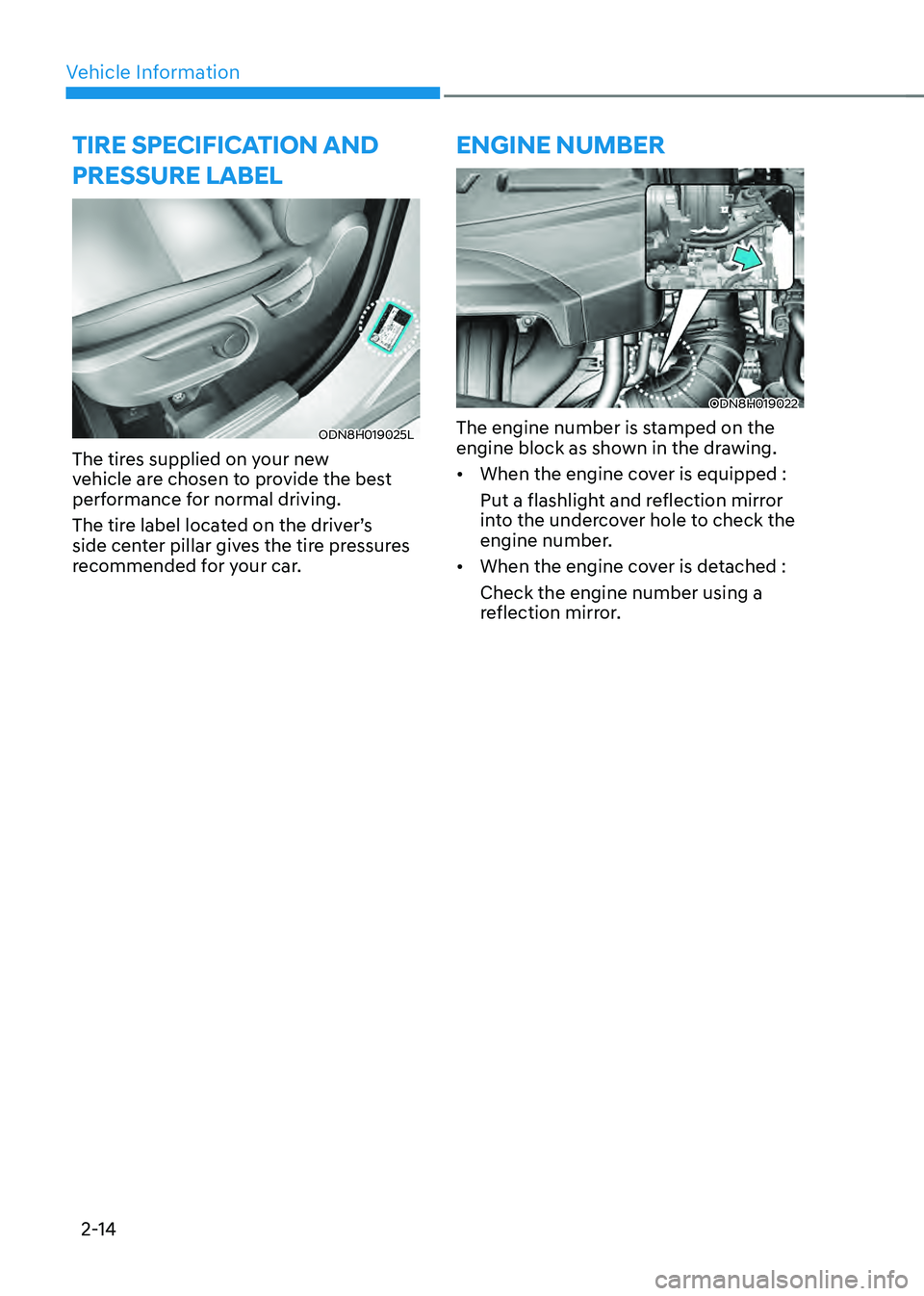
Vehicle Information
2-14
TIRE SPECIFICATION AND
PRESSURE LABEL
ODN8H019025L
The tires supplied on your new
vehicle are chosen to provide the best
performance for normal driving.
The tire label located on the driver’s
side center pillar gives the tire pressures
recommended for your car.
ENGINE NUMBER
ODN8H019022
The engine number is stamped on the
engine block as shown in the drawing.
• When the engine cover is equipped :
Put a flashlight and reflection mirror
into the undercover hole to check the
engine number.
• When the engine cover is detached :
Check the engine number using a
reflection mirror.
Page 47 of 527
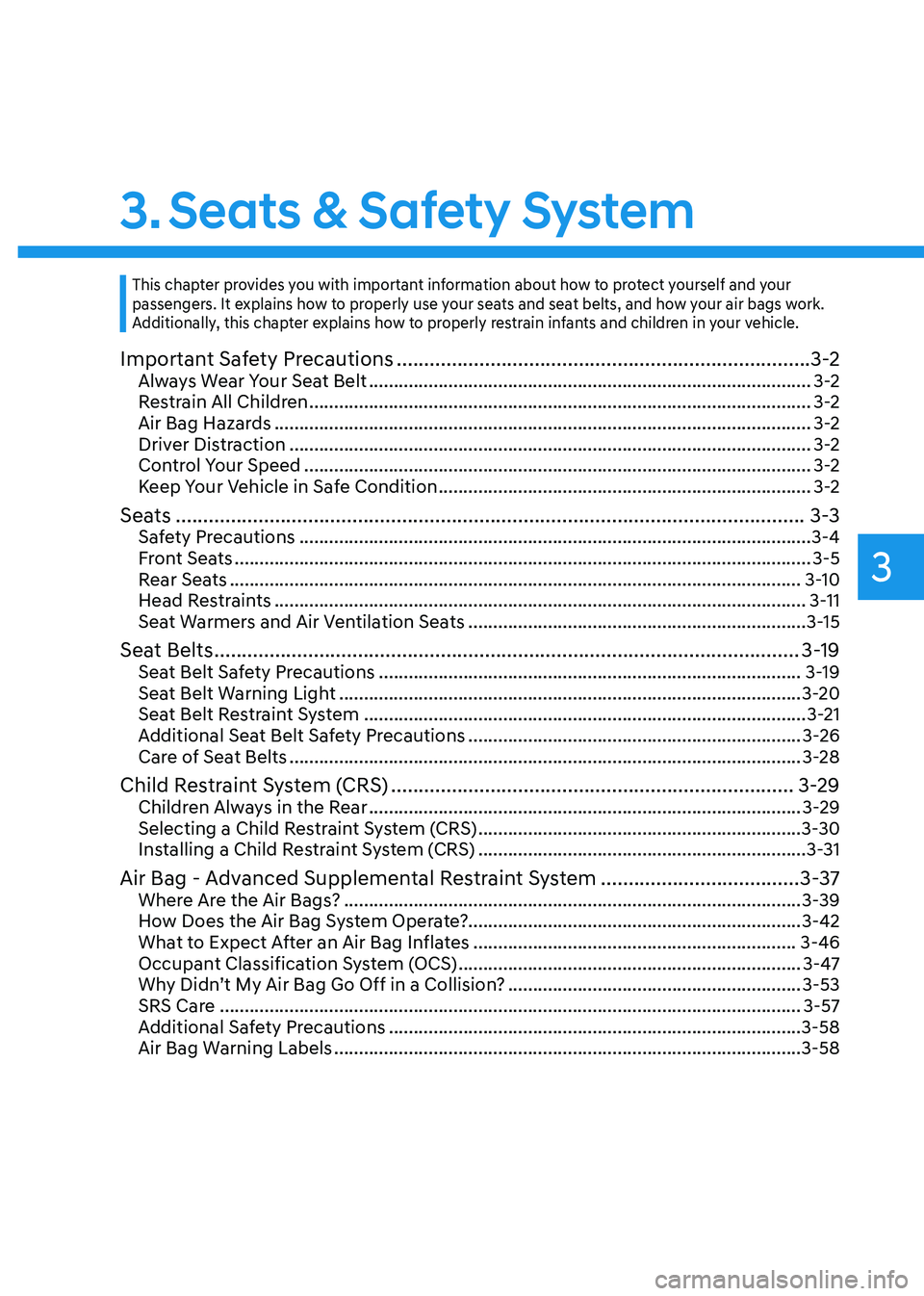
Safety System
3. Seats & Safety System
3
Important Safety Precautions ........................................................................\
...3-2Always Wear Your Seat Belt ........................................................................\
.................3-2
Restrain All Children ........................................................................\
.............................3-2
Air Bag Hazards ........................................................................\
....................................3-2
Driver Distraction ........................................................................\
.................................3-2
Control Your Speed ........................................................................\
..............................3-2
Keep Your Vehicle in Safe Condition ........................................................................\
...3-2
Seats ........................................................................\
..........................................3-3Safety Precautions ........................................................................\
...............................3-4
Front Seats ........................................................................\
............................................3-5
Rear Seats ........................................................................\
...........................................3-10
Head Restraints ........................................................................\
...................................3-11
Seat Warmers and Air Ventilation Seats ....................................................................3-15
Seat Belts ........................................................................\
..................................3-19Seat Belt Safety Precautions ........................................................................\
.............3-19
Seat Belt Warning Light ........................................................................\
.....................3-20
Seat Belt Restraint System ........................................................................\
.................3-21
Additional Seat Belt Safety Precautions ...................................................................3-26
Care of Seat Belts ........................................................................\
...............................3-28
Child Restraint System (CRS) ........................................................................\
.3-29Children Always in the Rear ........................................................................\
...............3-29
Selecting a Child Restraint System (CRS) .................................................................3-30
Installing a Child Restraint System (CRS) ..................................................................3-31
Air Bag - Advanced Supplemental Restraint System ....................................3-37Where Are the Air Bags? ........................................................................\
....................3-39
How Does the Air Bag System Operate? ...................................................................3-42
What to Expect After an Air Bag Inflates .................................................................3-46
Occupant Classification System (OCS) .....................................................................3-47
Why Didn’t My Air Bag Go Off in a Collision? ...........................................................3-53
SRS Care ........................................................................\
.............................................3-57
Additional Safety Precautions
........................................................................\
...........3-58
Air Bag Warning Labels ........................................................................\
......................3-58
This chapter provides you with important information about how to protect yourself and your
passengers. It explains how to properly use your seats and seat belts, and how your air bags work.
Additionally, this chapter explains how to properly restrain infants and children in your vehicle.
Page 51 of 527
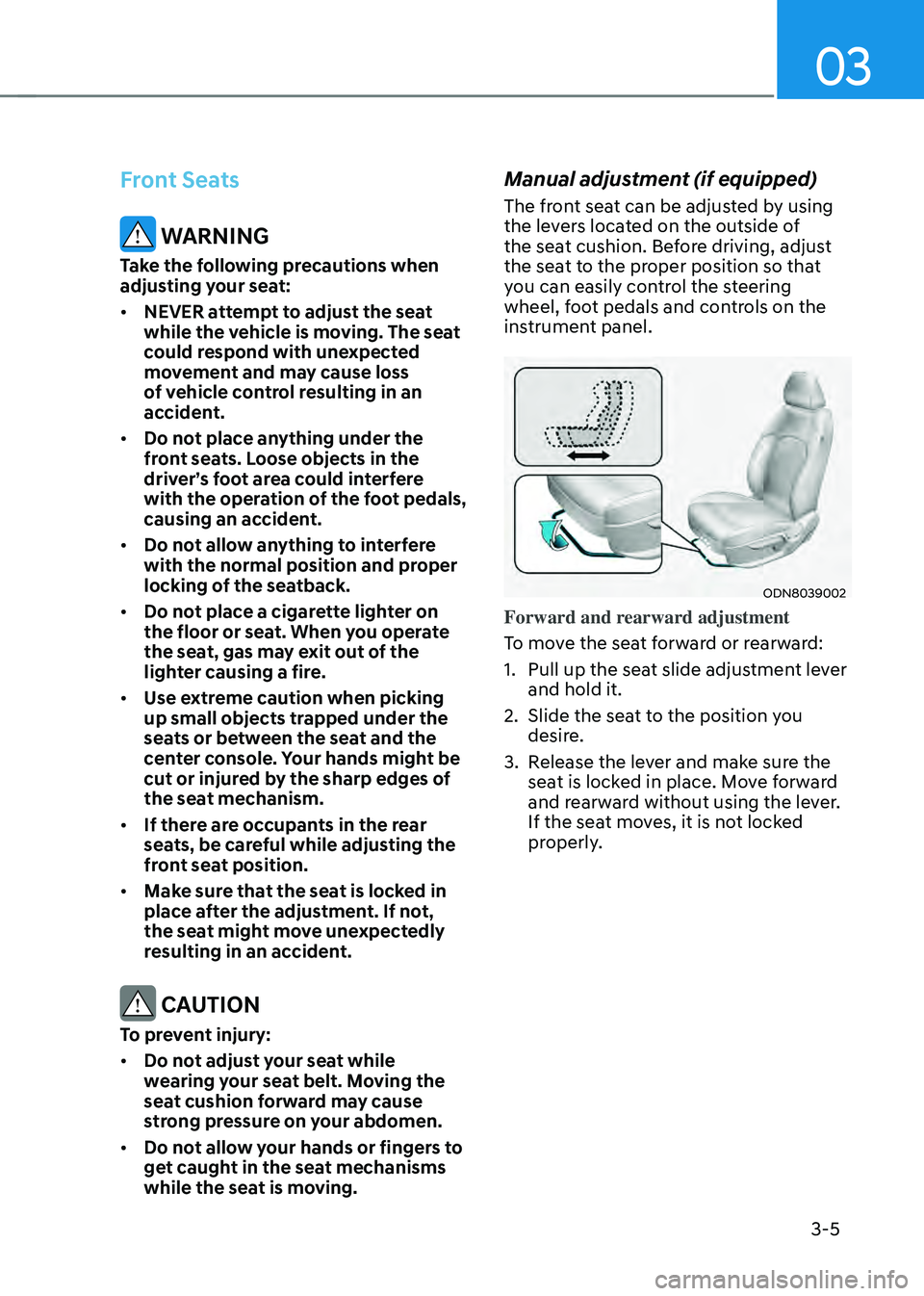
03
3-5
Front Seats
WARNING
Take the following precautions when
adjusting your seat:
• NEVER attempt to adjust the seat
while the vehicle is moving. The seat
could respond with unexpected
movement and may cause loss
of vehicle control resulting in an
accident.
• Do not place anything under the
front seats. Loose objects in the
driver’s foot area could interfere
with the operation of the foot pedals,
causing an accident.
• Do not allow anything to interfere
with the normal position and proper
locking of the seatback.
• Do not place a cigarette lighter on
the floor or seat. When you operate
the seat, gas may exit out of the
lighter causing a fire.
• Use extreme caution when picking
up small objects trapped under the
seats or between the seat and the
center console. Your hands might be
cut or injured by the sharp edges of
the seat mechanism.
• If there are occupants in the rear
seats, be careful while adjusting the
front seat position.
• Make sure that the seat is locked in
place after the adjustment. If not,
the seat might move unexpectedly
resulting in an accident.
CAUTION
To prevent injury:
• Do not adjust your seat while
wearing your seat belt. Moving the
seat cushion forward may cause
strong pressure on your abdomen.
• Do not allow your hands or fingers to
get caught in the seat mechanisms
while the seat is moving.
Manual adjustment (if equipped)
The front seat can be adjusted by using
the levers located on the outside of
the seat cushion. Before driving, adjust
the seat to the proper position so that
you can easily control the steering
wheel, foot pedals and controls on the
instrument panel.
ODN8039002
Forward and rearward adjustment
To move the seat forward or rearward:
1. Pull up the seat slide adjustment lever
and hold it.
2. Slide the seat to the position you
desire.
3. Release the lever and make sure the
seat is locked in place. Move forward
and rearward without using the lever.
If the seat moves, it is not locked
properly.
Page 52 of 527
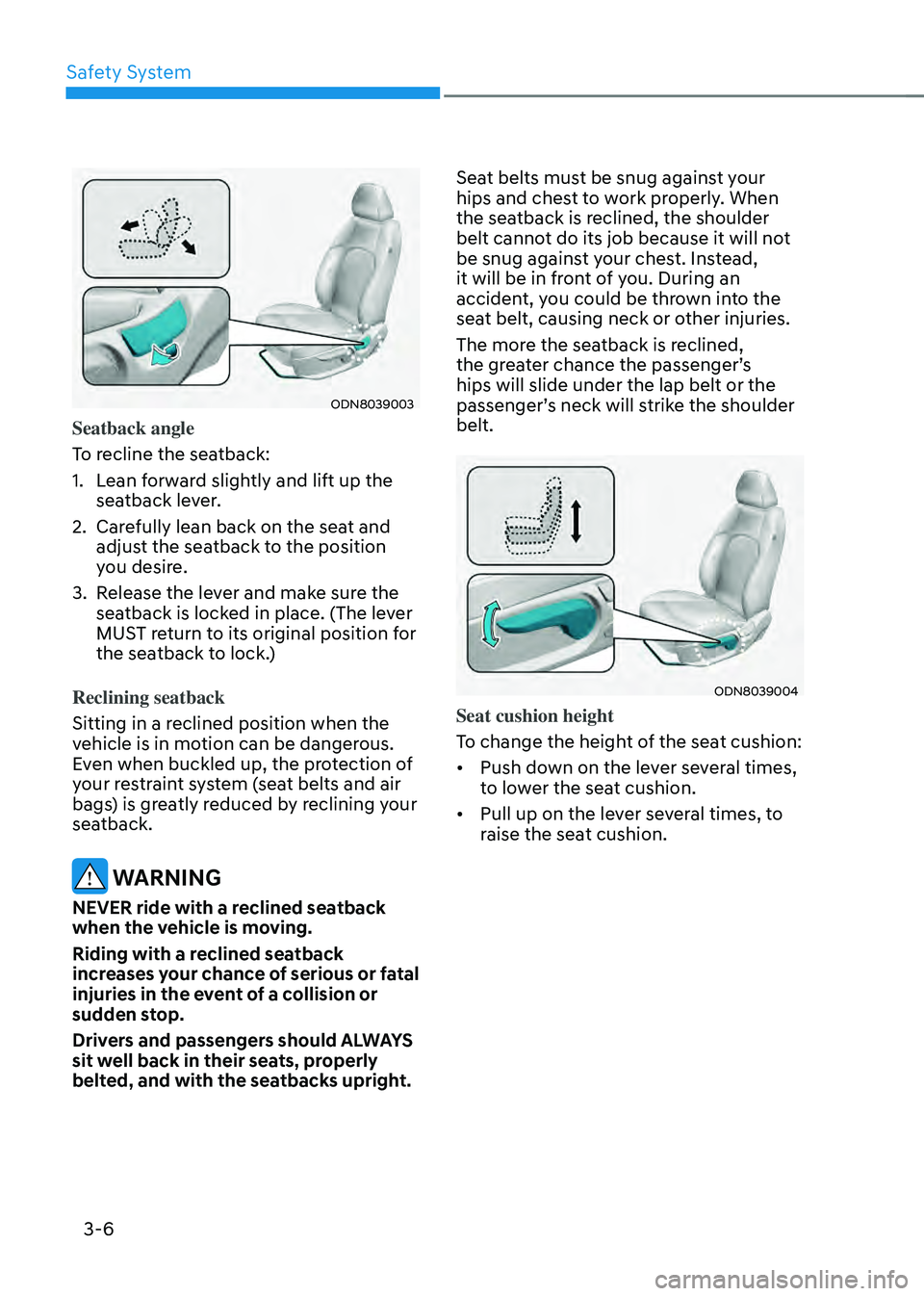
Safety System
3-6
ODN8039003
Seatback angle
To recline the seatback:
1. Lean forward slightly and lift up the
seatback lever.
2. Carefully lean back on the seat and
adjust the seatback to the position
you desire.
3. Release the lever and make sure the
seatback is locked in place. (The lever
MUST return to its original position for
the seatback to lock.)
Reclining seatback
Sitting in a reclined position when the
vehicle is in motion can be dangerous.
Even when buckled up, the protection of
your restraint system (seat belts and air
bags) is greatly reduced by reclining your
seatback.
WARNING
NEVER ride with a reclined seatback
when the vehicle is moving.
Riding with a reclined seatback
increases your chance of serious or fatal
injuries in the event of a collision or
sudden stop.
Drivers and passengers should ALWAYS
sit well back in their seats, properly
belted, and with the seatbacks upright. Seat belts must be snug against your
hips and chest to work properly. When
the seatback is reclined, the shoulder
belt cannot do its job because it will not
be snug against your chest. Instead,
it will be in front of you. During an
accident, you could be thrown into the
seat belt, causing neck or other injuries.
The more the seatback is reclined,
the greater chance the passenger’s
hips will slide under the lap belt or the
passenger’s neck will strike the shoulder
belt.
ODN8039004
Seat cushion height
To change the height of the seat cushion:
•
Push down on the lever several times,
to lower the seat cushion.
• Pull up on the lever several times, to
raise the seat cushion.